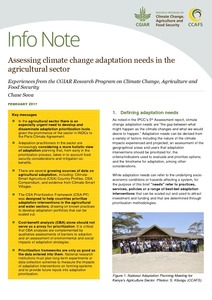Assessing climate change adaptation needs in the agricultural sector
 In the agricultural sector there is an especially urgent need to develop and disseminate adaptation prioritization tools given the prominence of the sector in INDCs to the Paris Climate Agreement. Adaptation practitioners in the sector are increasingly considering a more holistic view of adaptation planning that, from early in the prioritization process, takes in to account food security considerations and mitigation co-benefits. There are several growing sources of data on agricultural adaptation, including: Climate-Smart Agriculture (CSA) Country Profiles, CSA Compendium, and evidence from Climate-Smart Villages. The CCAFS-CIAT CSA Prioritization Framework (CSA-PF) was designed to help countries prioritize adaptation interventions in the agricultural and water sectors, drawing on known practices to develop adaptation portfolios that can be scaled out. Cost-benefit analysis (CBA) alone should not serve as a proxy for prioritization. It is critical that CBA analyses are complemented by qualitative assessments of barriers to adoption and an assessment of environmental and social impacts of adaptation strategies. Prioritization frameworks are only as good as the data entered into them. National research institutions must plan long-term experiments or data collection schemes to measure the impacts of adaptation interventions on farming systems and to provide future inputs into adaptation prioritization.
In the agricultural sector there is an especially urgent need to develop and disseminate adaptation prioritization tools given the prominence of the sector in INDCs to the Paris Climate Agreement. Adaptation practitioners in the sector are increasingly considering a more holistic view of adaptation planning that, from early in the prioritization process, takes in to account food security considerations and mitigation co-benefits. There are several growing sources of data on agricultural adaptation, including: Climate-Smart Agriculture (CSA) Country Profiles, CSA Compendium, and evidence from Climate-Smart Villages. The CCAFS-CIAT CSA Prioritization Framework (CSA-PF) was designed to help countries prioritize adaptation interventions in the agricultural and water sectors, drawing on known practices to develop adaptation portfolios that can be scaled out. Cost-benefit analysis (CBA) alone should not serve as a proxy for prioritization. It is critical that CBA analyses are complemented by qualitative assessments of barriers to adoption and an assessment of environmental and social impacts of adaptation strategies. Prioritization frameworks are only as good as the data entered into them. National research institutions must plan long-term experiments or data collection schemes to measure the impacts of adaptation interventions on farming systems and to provide future inputs into adaptation prioritization.
Related Content
- A common framework for agriculture and land use in the nationally determined contributions
- South Asia's hotspots: impacts of temperature and precipitation changes on living standards
- ClimAfrica- climate change predictions in Sub-Saharan Africa: impacts and adaptations
- Mapping multiple climate-related hazards in South Asia
- National climate change governance
